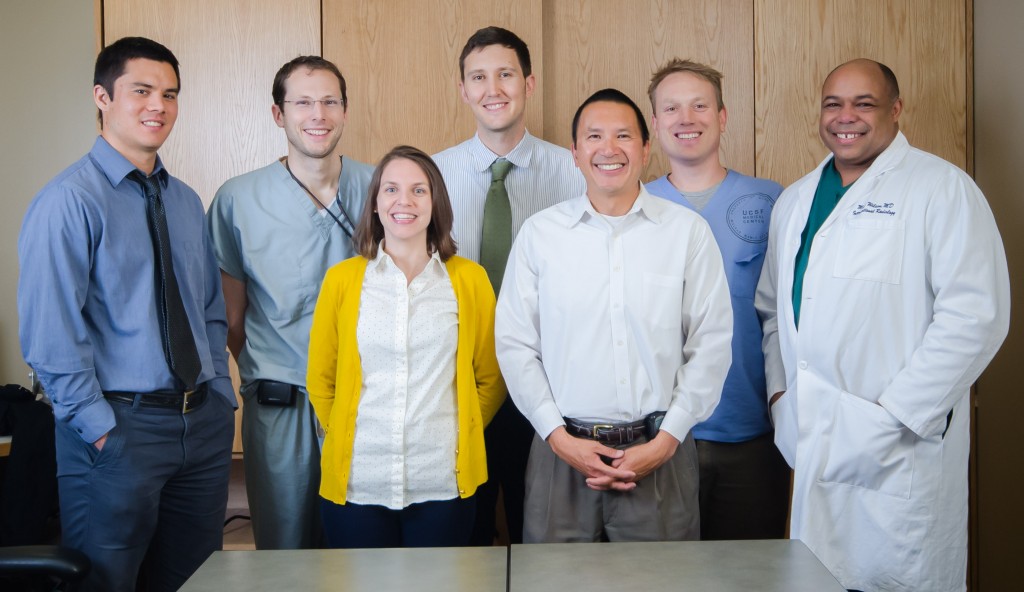SFGH Radiology Team Meets the Challenge after Asiana Airlines Disaster
It was a quiet morning on Saturday, July 6. Radiology resident Kim Kallianos, MD, was handling routine cases at San Francisco General Hospital & Trauma Center (SFGH) during her first day of call as a third-year resident. She and her back-up call resident, Marc Mabray, MD, started hearing hospital public address announcements that there had been a large-scale disaster and all staff needed to be prepared.
From that point on, the Radiology Service scaled up its staff and resources to handle what would eventually be 53 passengers and crew brought to the hospital’s trauma center that day. The most critically injured people came right away—some with burns, others with fractures and a number with internal injuries, head injuries or spinal injuries. Beginning at 1:00 p.m. Radiology performed and read a steady stream of images through the afternoon and evening, and that continued through the next day. In the first eight hours, the team read more than 70 CT and MRI studies and well beyond the average number of X-ray exams, with Radiology faculty Thienkhai Vu, MD, Esther Yuh, MD, PhD, Terry Lynch, MD and Tom Urbania, MD handling the bulk of them.
During any trauma activation, surgeons, emergency physicians, pediatricians and others on the trauma team want to speak to a radiologist and review the imaging findings in person. Radiology plays a critical role in identifying the abnormalities, synthesizing that information and communicating it directly to the trauma team and the emergency department.
This was an altogether greater order of magnitude, however. Chiefs and faculty from most departments, trainees and nurses all congregated in the main Radiology reading room, which became a kind of “nerve center.” The imaging studies from all the crash victims were reviewed in that setting. The entire Trauma Surgery service was there, as well as physicians from Neurosurgery, Neurology, Emergency Medicine, Pediatrics, Orthopedics and several high-level nurses from those areas to review all the images and other clinical information and decide answers to critical questions: Is this patient stable? Can this patient go home? Does this patient go to the OR? Is this patient admitted to a specific service? Is this the child of an injured patient who will be admitted to pediatrics even though the child is not acutely injured?
That 5:00 “rounds” was organized on the fly by Drs. Lynch and Urbania and the Radiology residents, led by chief resident John-Paul Yu, MD, PhD so they could be more structured in approach. They made a snap decision that this would be the best way to ensure that all the imaging studies on all the patients were seen by whoever needed to view them.
Mark Wilson, MD, Chief of Radiology at SFGH, was present for the 5:00 rounds. “I thought that was a brilliant idea, and we are codifying this so it becomes a procedure for us in times of disaster,” Dr. Wilson said. “Medical imaging currently plays an essential role in the triage and treatment of trauma patients, CT in particular. Given the role of imaging—whether we are dealing with traumatic brain injury, abdominal or chest trauma, musculoskeletal trauma or something else—it would make sense for Radiology to be a nexus of decision-making with all the clinical services present.”
It is important to note that the radiologists do not function in a vacuum. The Radiology supervisors and technologists responded with equal aplomb. There were twice the number of technologists present on all shifts that day along with supervisors Rafael Ibarra, RT, Frank Cubias, RT and Joselito Cruz, RT, all efficiently working at triaging patients and getting them scanned as fast and thoroughly as possible.
As Sue Currin, RN, MSN, Chief Executive Officer of San Francisco General Hospital and Trauma Center, said: “I am very proud of how every department pulled together to provide outstanding trauma services. I especially want to thank the Trauma, Emergency, OR, Critical Care and Radiology staff who were poised and synchronized in how they planned and coordinated the care of so many patients.”

